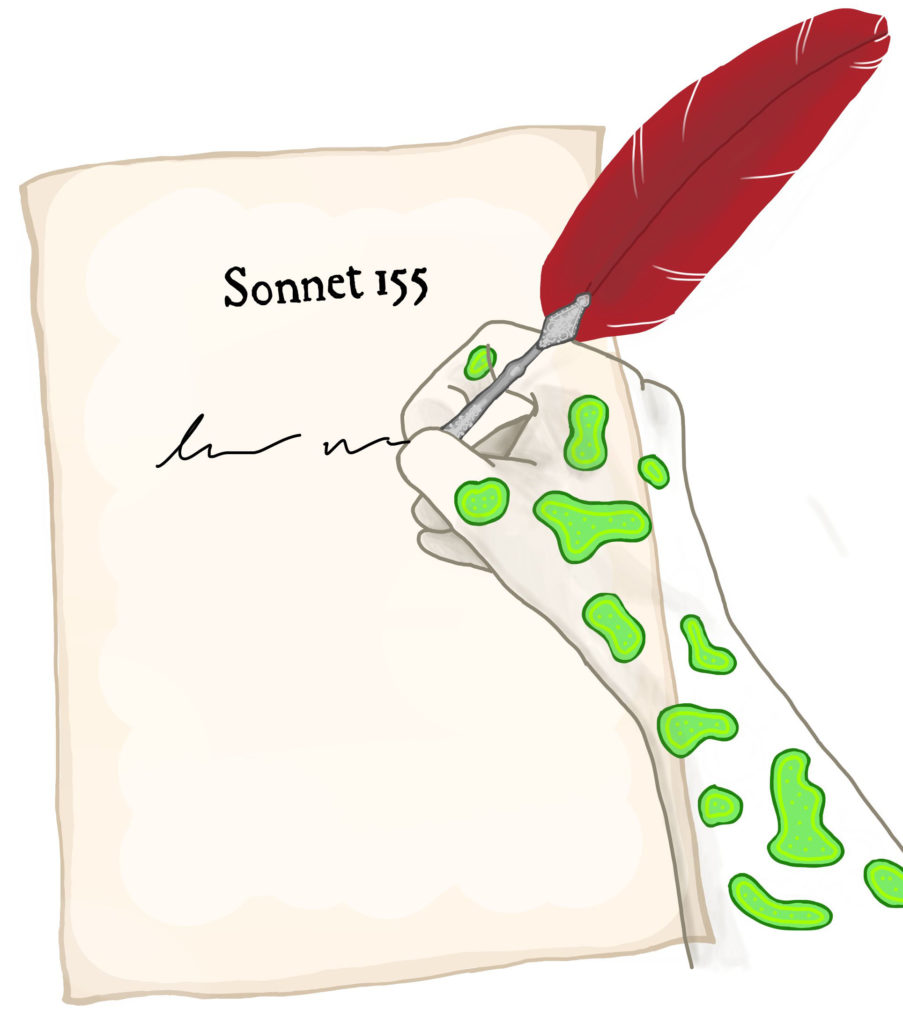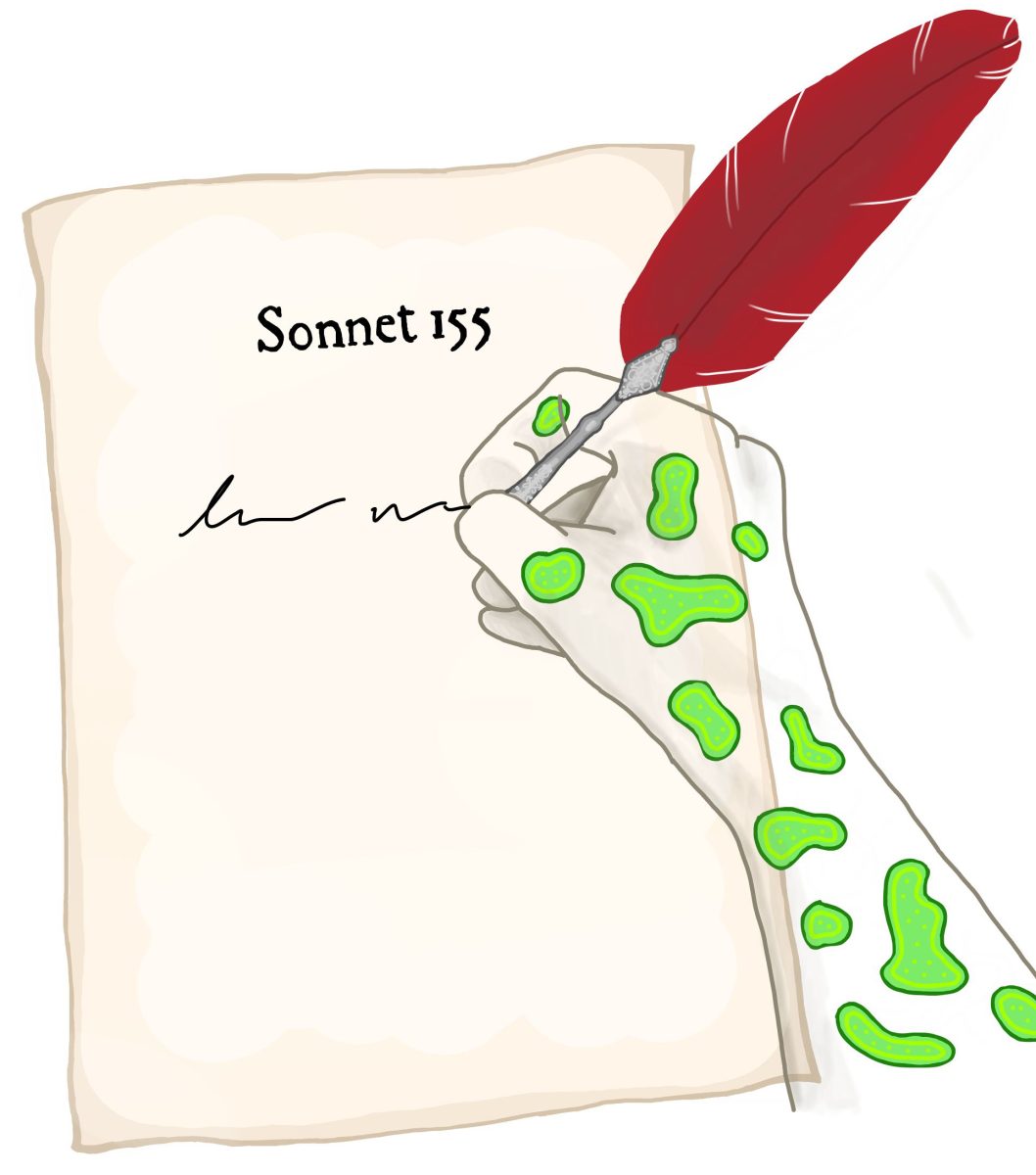Imagine a random internet search leads you to a ‘newly discovered’ Shakespeare sonnet. Intrigued, you start looking for more information on it only to see that there’s not one ‘newly discovered’ sonnet, but many, and most of them are numbered 155. Further research doesn’t give you much of an explanation, and you’re left wondering what these are. Maybe your searching led you to this article, in which case, you’ve found the right place, as I’m here to tell you about this phenomenon.
Sonnet 155s are imitations or parodies of Shakespeare’s sonnets. They are generally written using old-style language and in sonnet form. The name “Sonnet 155” comes from Shakespeare’s published 154 sonnets, where if a new, subsequent sonnet by Shakespeare were discovered, it would be considered the 155th.

Sonnet 155s can range from poems really trying to imitate Shakespeare, such as Studio 360’s “Fakespeare” sonnet competition, to comedic, such as Anthony Lydgate’s cannabis sonnets, and every topic in between or beyond.
The most recent Sonnet 155 to be published online, written by SpaceSquid editor D Chang, took the idea of spaceships and steampunk into Shakespeare’s world. Chang said that his original idea was to compose a sonnet that emulates Shakespeare’s writing.
“I underestimated the task originally,” Chang said. “At first it was more of a joke; a joke with some ambition to it because I wanted to capture the feel of a Shakespeare sonnet and I wanted to write something people would enjoy reading.”
After enlisting the help of UT English professor Martin Kevorkian, Chang came up with a sonnet that he was really proud of. However, Chang isn’t the only person to have written a so-called “Sonnet 155”. In fact, there’s a whole underlying tradition of Sonnet 155s, and interestingly, many of the authors, like Chang, participated in this tradition without knowing the tradition itself existed.
Dr. Douglas Bruster, English professor and UT’s own “towering Shakespeare expert” (as described by Kevorkian), confirmed this idea of a tradition involving the making of new Shakespeare-style sonnets. He said that this is a tradition that predates the modern era and actually goes back to Shakespeare’s time.
“All of a sudden there was a boom of Petrarchan verse in England during the Elizabethan era,” Bruster said. “Every young writer was writing sonnets. What you see in the tradition of Sonnet 155, or alternate Shakespeare sonnets, was actually built into the whole process of sonnet writing itself. People are merely continuing something that was there when Shakespeare wrote his sonnets because he was merely continuing what Petrarch and many others had done.”
If you don’t know who Petrarch is, he predates Shakespeare by about 250 years and his sonnets are what paved the way for what we now know as the traditional sonnet form. In short, the Sonnet 155 tradition of modern writers parodying or playing off Shakespeare is the same thing Shakespeare and his contemporaries did to Petrarch.
Bruster relates sonnet writing to catching an illness. The illness he describes is one that has stood the test of time, as people have been catching it for more than 400 years.
“(Sonnets) are a kind of sickness that one catches and works to get out of their system by repeating over and over,” Bruster said. “Petrarch wrote 366, Shakespeare wrote 154, and his contemporaries wrote just as many. Once people catch it, they feel the need to perpetuate it by writing sonnets.”
However, like any parody or imitation, they’re never perfect. Bruster has provided evidence to support claims that 325 lines of material added to Thomas Kyd’s “The Spanish Tragedy” were written by Shakespeare, yet he says he has never encountered a perfect Shakespeare imitation, even when written by professors who teach Shakespeare.
“It’s impossible to write more than one line of psudo-Shakespeare that’s convincing,” Bruster said. “The second you make the turn at the end of the line, your mind reveals itself to be different from the Elizabethans’. It’s just impossible to manufacture more than one line to persuade someone that it came from 400 years ago”
Now knowing about the tradition himself, Chang said he likes how Shakespeare’s work, even some work relatively recently being attributed to him, leaves an open end for people to add to.
“The ambiguity about where Shakespeare begins and ends has caused a lot a scholastic questioning,” Chang said. “It creates an open end where people can claim, to comedic effect, that they found more work by Shakespeare, and it keeps engagement with his work alive.”
Bruster sees it as a community of people who love Shakespeare’s work writing love letters to him in the form of their own sonnets.
“I am heartened by (this tradition) because anytime people are reading rich and complex and sometimes difficult language from the past that’s a good thing,” Bruster said. “It makes us smarter, it makes us more flexible, it deepens our habits and powers of analysis. I think it’s fantastic that people are still reading these poems and are writing back in tradition by writing alternate sonnets. It testifies to how good he was as a writer.”
While researching for this article, I caught the sonnet virus, too. I wrote my own sonnet inspired by the other Sonnet 155s, and I’m encouraging our readers to do the same. You can find some Dr. Bruster-approved basic sonnet guidelines here and submit a sonnet to us using the form below. We look forward to reading your sonnets!
“Sonnet 155”
Although there are many a wall I hit
By research, writing, editing and more,
‘Tis for you, dear reader, I do attempt
This noble art that, to my very core,
I do only to keep you really true.
This trade of words to truth and fact behold
Although hardship does always pass on through
To a better world we seek to unfold.
And more with this trade of truthful writer
Do principally hold the same as I,
That the spread of knowledge is the lighter
Of a flame much too strong to go awry.
And if the strife is too much to bear through,
All of the heartache was worth it for you.
































